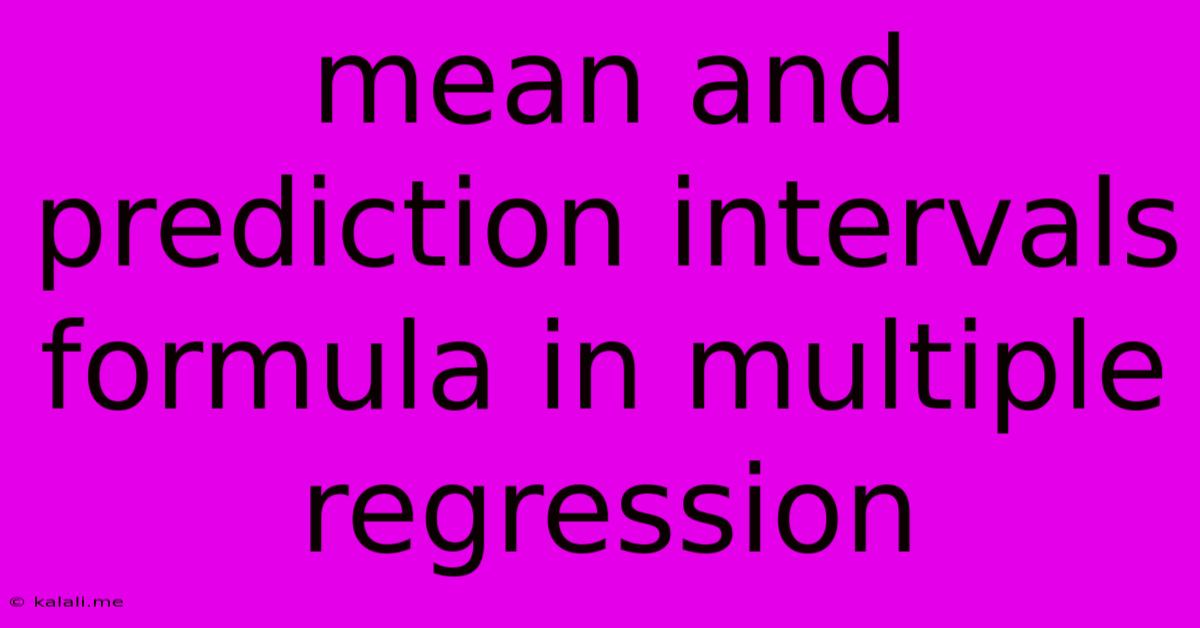Mean And Prediction Intervals Formula In Multiple Regression
Kalali
May 23, 2025 · 4 min read

Table of Contents
Understanding Mean and Prediction Intervals in Multiple Regression
Multiple regression analysis is a powerful statistical technique used to model the relationship between a dependent variable and two or more independent variables. While the regression equation provides a predicted value for the dependent variable, it doesn't capture the uncertainty inherent in the prediction. This is where mean and prediction intervals come in. This article will delve into the formulas and interpretations of these crucial intervals. Understanding these intervals is critical for correctly interpreting the results of a multiple regression analysis and making informed decisions based on your model.
What are Mean and Prediction Intervals?
In the context of multiple regression, both mean and prediction intervals quantify the uncertainty associated with predictions. However, they represent different types of uncertainty:
-
Mean Interval (Confidence Interval for the Mean): This interval estimates the average value of the dependent variable for a given set of independent variable values. It reflects the uncertainty in estimating the population mean response. A narrower interval indicates greater precision in estimating the mean.
-
Prediction Interval (Confidence Interval for a Single Prediction): This interval estimates the range within which a single future observation of the dependent variable will fall, given a specific set of independent variable values. It incorporates the uncertainty in estimating the mean response plus the inherent variability of the dependent variable itself. Therefore, a prediction interval is always wider than the corresponding mean interval.
Formulas for Mean and Prediction Intervals in Multiple Regression
The formulas for calculating these intervals are based on the estimated regression coefficients, the standard error of the estimate, and the design matrix (X). While the exact calculations are complex and typically handled by statistical software, understanding the underlying components is vital.
Let's define some key terms:
- ŷ: The predicted value of the dependent variable.
- X: The design matrix (matrix of independent variable values).
- β̂: The vector of estimated regression coefficients.
- s: The standard error of the estimate (a measure of the variability of the data around the regression line).
- n: The sample size.
- k: The number of independent variables.
- t<sub>α/2, n-k-1</sub>: The critical t-value for a given significance level (α) and degrees of freedom (n-k-1).
The formulas are then:
1. Mean Interval:
ŷ ± t<sub>α/2, n-k-1</sub> * s * √[X(X<sup>T</sup>X)<sup>-1</sup>X<sup>T</sup>]
2. Prediction Interval:
ŷ ± t<sub>α/2, n-k-1</sub> * s * √[1 + X(X<sup>T</sup>X)<sup>-1</sup>X<sup>T</sup>]
Notice the key difference: the prediction interval formula adds "1" inside the square root. This additional term accounts for the inherent variability of individual observations around the regression line.
Interpretation and Practical Considerations
-
Width of the Intervals: Wider intervals indicate greater uncertainty in the prediction. Factors influencing width include sample size (larger samples lead to narrower intervals), variability of the data (higher variability leads to wider intervals), and the distance of the predictor values from the mean of the predictors (extrapolation leads to wider intervals).
-
Significance Level (α): Commonly, α is set at 0.05, resulting in a 95% confidence interval. This means that if you were to repeat the analysis many times, 95% of the calculated intervals would contain the true mean (for mean intervals) or the true value of a future observation (for prediction intervals).
-
Software Implementation: Statistical software packages like R, SPSS, and SAS readily compute these intervals. You don't need to manually calculate these complex formulas. Focus instead on understanding their meaning and implications for your analysis.
-
Extrapolation: Be cautious when making predictions outside the range of your observed independent variable values (extrapolation). Predictions in these areas are highly uncertain and should be interpreted with extreme caution.
Conclusion
Mean and prediction intervals are essential tools for interpreting the results of multiple regression analysis. While the regression equation provides a point estimate, these intervals offer a more complete picture by quantifying the uncertainty associated with both the mean response and individual predictions. Understanding the differences between these intervals and their practical implications is vital for drawing accurate and reliable conclusions from your multiple regression models. Remember to always consider the context of your data and the limitations of your model when interpreting these intervals.
Latest Posts
Latest Posts
-
How To Extend A Surge Protector
May 23, 2025
-
Stop In The Name Of The Law
May 23, 2025
-
Write The Number Pi Correct To 5 Decimal Places
May 23, 2025
-
Show Slave Status Just Output Slave Io Running
May 23, 2025
-
How Much Is One Box Powdered Sugar
May 23, 2025
Related Post
Thank you for visiting our website which covers about Mean And Prediction Intervals Formula In Multiple Regression . We hope the information provided has been useful to you. Feel free to contact us if you have any questions or need further assistance. See you next time and don't miss to bookmark.